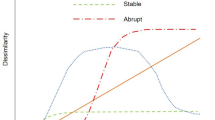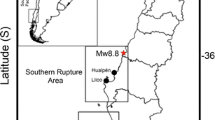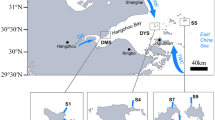Abstract
Here we considered two fundamental questions in community ecology regarding the relationship between seasonal changes in community structure and environmental gradients: (i) How does the magnitude of seasonal changes in community structure vary along an environmental gradient? (ii) How do the processes driving seasonal changes in community structure vary along an environmental gradient? To examine these questions, we investigated intertidal sessile assemblages inhabiting a notable vertical environmental gradient and fitted a transition probability matrix model to decadal time series data gathered at 25 plots along the Pacific coast of eastern Hokkaido, Japan. We found that the magnitude of seasonal changes in community structure was the largest at mid shore. The major processes driving seasonal changes in community structure changed vertically, reflecting the indirect influence of vertical changes in the physical environment on the vertical distributions of species. An unexpected finding was that the magnitude of seasonal changes in community structure did not reflect the strength of seasonal variation in the physical environment. One explanation may be that sessile organisms living on the high shore have a broad tolerance to environmental stress and are thus less sensitive to the large seasonal variation in physical stress.



Similar content being viewed by others
References
Alam AKMR, Noda T (2016) An experimental evaluation of the direct and indirect effects of endemic seaweeds, barnacles, and invertebrate predators on the abundance of the introduced rocky intertidal barnacle Balanus glandula. Popul Ecol 58:507–514
Alam AKMR, Hagino T, Fukaya K, Okuda T, Nakaoka M, Noda T (2014) Early phase of the invasion of Balanus glandula along the coast of Eastern Hokkaido: changes in abundance, distribution, and recruitment. Biol Invasions 16:1699–1708
Asakura A (2003) Biogeography. In: Wada K (ed) Ecology of marine benthos. Tokai University Press, Hatano, pp 303–367
Austin MP (1985) Continuum concept, ordination methods, and niche theory. Annu Rev Ecol Syst 16:29–61
Bazterrica MC, Silliman BR, Hidalgo FJ, Crain CM, Bertness MD (2007) Limpet grazing on a physically stressful Patagonian rocky shore. J Exp Mar Biol Ecol 353:22–34
Bertness MD, Leonard GH, Levine JM, Schmidt PR, Ingraham AO (1999) Testing the relative contribution of positive and negative interactions in rocky intertidal communities. Ecology 80:2711–2726
Bird JM, Hodkinson JD (1999) Species at the edge of their range: the significance of the thermal environment for the distribution of congeneric Craspedolepta species (Sternorrhyncha: Psylloidea) living on Chamerion angustifolium (Onagraceae). Eur J Entomol 96:103–109
Blume E, Bischoff M, Reichert JM, Moorman T, Konopka A, Turco RF (2002) Surface and subsurface microbial biomass, community structure and metabolic activity as a function of soil depth and season. Appl Soil Ecol 20:171–181
Bownes S, McQuaid CD (2006) Will the invasive mussel Mytilus galloprovincialis Lamarck replace the indigenous Perna perna L. on the south coast of South Africa? J Exp Mar Biol Ecol 338:140–151
Bownes S, McQuaid CD (2009) Mechanisms of habitat segregation between an invasive and an indigenous mussel: settlement, post-settlement mortality and recruitment. Mar Biol 156:991–1006
Bownes S, McQuaid CD (2010) Mechanisms of habitat segregation between an invasive (Mytilus galloprovincialis) and an indigenous (Perna perna) mussel: adult growth and mortality. Mar Biol 157:1799–1810
Briggs JC (1995) Global biogeography. Elsevier, Amsterdam
Castenholz RW (1961) The effect of grazing on marine littoral diatom populations. Ecology 42:783–794
Caswell H (2001) Matrix population models: construction, analysis, and interpretation, 2nd edn. Sinauer, Sunderland
Chapman ARO (1990) Effects of grazing, canopy cover and substratum type on the abundances of common species of seaweeds inhabiting littoral fringe tide pools. Bot Mar 33:319–326
Chomsky O, Kamenir Y, Hyams M, Dubinsky Z, Chadwick-Furman NE (2004) Effects of temperature on growth rate and body size in the Mediterranean Sea anemone Actinia equina. J Exp Mar Biol Ecol 313:63–73
Connell JH (1961a) Effects of competition, predation by Thais lapillus, and other factors on natural populations of the barnacle Balanus balanoides. Ecol Monogr 31:61–104
Connell JH (1961b) The influence of interspecific competition and other factors on the distribution of the barnacle Chthamalus stellatus. Ecology 42:710–723
Connell JH (1972) Community interactions on marine rocky intertidal shores. Annu Rev Ecol Syst 3:169–192
Cubit J (1984) Herbivory and the seasonal abundance of algae on a high intertidal rocky shore. Ecology 65:1904–1917
Dayton PK (1971) Competition, disturbance, and community organization: the provision and subsequent utilization of space in a rocky intertidal community. Ecol Monogr 41:351–389
Elton CS (1958) The ecology of invasion by animals and plants. Methuen, London
Foster BA (1971) Desiccation as a factor in the intertidal zonation of barnacles. Mar Biol 8:12–29
Frank PW (1965) The biodemography of an intertidal snail population. Ecology 46:831–834
Fukaya K, Royle JA (2013) Markov models for community dynamics allowing for observation error. Ecology 94:2670–2677
Fukaya K, Okuda T, Hori M, Yamamoto T, Nakaoka M, Noda T (2013) Variable processes that determine population growth and an invariant mean-variance relationship of intertidal barnacles. Ecosphere 4:1–20
Hedgpeth JW (1957) Treatise on marine ecology and paleoecology, vol 1 Ecology. Geological Society of America, Boulder
Helmuth BST, Hofmann GE (2001) Microhabitats, thermal heterogeneity, and patterns of physical stress in the rocky intertidal zone. Biol Bull-US 201:374–384
Hill MF, Witman JD, Caswell H (2004) Markov chain analysis of succession in a rocky subtidal community. Am Nat 164:46–61
Hori M, Noda T (2001) An unpredictable indirect effect of algal consumption by gulls on crows. Ecology 82:3251–3256
Horvitz C, Schemske DW, Caswell H (1997) The relative “importance” of lifehistory stages to population growth: prospective and retrospective analyses. In: Tuljapurkar S, Caswell H (eds) Structured-population models in marine, terrestrial, and freshwater systems. Chapman and Hall, New York, pp 247–271
Hothorn T, Hornik K (2013) exactRankTests: exact distributions for rank and permutation tests. https://CRAN.R-project.org/package=exactRankTests. Accessed 22 Aug 2017
Huan L, Gao S, Xie XJ, Tao WR, Pan GH, Zhang BY, Niu JF, Lin AP, He LW, Wang GC (2014) Specific photosynthetic and morphological characteristics allow macroalgae Gloiopeltis furcata (Rhodophyta) to survive in unfavorable conditions. Photosynthetica 52:281–287
Jernakoff P (1985) An experimental evaluation of the influence of barnacles, crevices and seasonal patterns of grazing on algal diversity and cover in an intertidal barnacle zone. J Exp Mar Biol Ecol 88:287–302
Kaehler S, Williams GA (1997) Do factors influencing recruitment ultimately determine the distribution and abundance of encrusting algae on seasonal tropical shores? Mar Ecol Prog Ser 156:87–96
Legendre P, Cáceres MD (2013) Beta diversity as the variance of community data: dissimilarity coefficients and partitioning. Ecol Lett 16:951–963
Lewis JR (1964) The ecology of rocky shores. English University Press, London
Lubchenco J (1980) Algal zonation in a New England rocky intertidal community: An experimental analysis. Ecology 61:333–344
Lubchenco J, Cubit J (1980) Heteromorphic life histories of certain marine algae as adaptations to variations in herbivory. Ecology 61:676–687
Markham JW (1973) Observations on the ecology of Laminaria sinclairii on three northern Oregon beaches. J Phycol 9:336–341
McCourt RM (1984) Seasonal patterns of abundance, distributions, and phenology in relation to growth strategies of three Sargassum species. J Exp Mar Biol Ecol 74:141–156
Menge BA (1976) Organization of the New England rocky intertidal community: role of predation, competition and environmental heterogeneity. Ecol Monogr 46:355–393
Menge BA (1978a) Predation intensity in a rocky intertidal community: effect of an algal canopy, wave action and desiccation on predator feeding rates. Oecologia 34:17–35
Menge BA (1978b) Predation intensity in a rocky intertidal community. relation between predator forging activity and environmental harshness. Oecologia 34:1–16
Menge BA, Branch GM (2001) Rocky intertidal communities. In: Bertness MD, Gaines SD, Hay ME (eds) Marine community ecology. Sinauer Associates, Sutherland, Massachusetts, pp 221–225
Menge BA, Sanford E, Daley BA, Freidenburg TL, Hudson G, Lubchenco J (2002) An inter-hemispheric comparison of bottom-up effects on community structure: insights revealed using the comparative-experimental approach. Ecol Res 17:1–16
Munroe DM, Noda T (2009) Spatial pattern of rocky intertidal barnacle recruitment: comparison over multiple tidal levels and years. J Mar Biol Assoc UK 89:345–353
Newell RC (1979) Biology of intertidal animals. Paul Elek (Scientific books), Limited, London
Noda T (2004) Spatial hierarchical approach in community ecology: a way beyond high context-dependency and low predictability in local phenomena. Popul Ecol 46:105–117
Noda T, Minamiura N, Miyamoto S (2003) Seasonal changes in an intertidal annual algal assemblage in the Northern Japan: the role of preemption and grazing on algal replacement. Ecol Res 18:695–709
Norton WJ (1985) The zonation of seaweeds on rocky shores. In: Moore PG, Seed R (eds) The ecology of rocky coasts. Hodder & Stoughton, London, pp 7–21
Paine RT (1971) A short-term experimental investigation of resource partitioning in a New Zealand rocky intertidal system. Ecology 52:1096–1106
Paine RT (1976) Size-limited predation: an observational and experimental approach with the Mytilus-Pisaster interaction. Ecology 5:858–873
Paine RT, Levin SA (1981) Intertidal landscapes: disturbance and the dynamics of pattern. Ecol Monogr 51:145–178
Pineda J, Porri F, Starczak V, Blythe J (2010) Causes of decoupling between larval supply and settlement and consequences for understanding recruitment and population connectivity. J Exp Mar Biol Ecol 392:9–21
Plummer M (2003) JAGS: a program for analysis of Bayesian graphical models using Gibbs sampling. Available at: http://mcmc-jags.sourceforge.net/. Accessed 22 Aug 2017
Plummer M (2013) rjags: Bayesian graphical models using MCMC. http://CRAN.R-project.org/package=rjags. Accessed 22 Aug 2017
R Development Core Team (2016) R: a language and environment for statistical computing. R Foundation for Statistical Computing, Vienna, Austria. Available at: http://www.R-project.org. Accessed 22 Aug 2017
Raffaelli D, Hawkins S (1996) Intertidal ecology. Chapman & Hall, London
Raimondi PT (1988) Settlement cues and determination of the vertical limit of an intertidal barnacle. Ecology 69:400–407
Rilov G, Schiel DR (2011) Community regulation: the relative importance of recruitment and predation intensity of an intertidal community dominant in a seascape context. PLOS ONE 6:e23958
Rius M, McQuaid (2006) Wave action and competitive interaction between the invasive mussel Mytilus galloprovincialis and the indigenous Perna perna in South Africa. Mar Biol 150:69–78
Roberts DA, Hofmann GE, Somero GN (1997) Heat-shock protein expression in Mytilus californianus: acclimatization (seasonal and tidal-height comparisons) and acclimation effects. Biol Bull-UK 192:309–320
Robles C (1982) Disturbance and predation in an assemblage of herbivorous Diptera and algae on rocky shores. Oecologia 54:23–31
Sandrini-Neto L, Camargo MG (2014) GAD: an R package for ANOVA designs from general principles. http://CRAN.R-project.org/package=GAD. Accessed 22 Aug 2017
Sanford E (2002) Water temperature, predation, and the neglected role of physiological rate effects in rocky intertidal communities. Integr Comp Biol 42:881–891
Sanford E, Bermudez D, Bertness MD, Gaines SD (1994) Flow, food supply and acorn barnacle population dynamics. Mar Ecol Prog Ser 104:49–62
Schneider KR (2008) Heat stress in the intertidal: comparing survival and growth of an invasive and native mussel under a variety of thermal conditions. Biol Bull 215:253–264
Seapy RR, Littler MM (1982) Population and species diversity fluctuations in a rocky intertidal community relative to severe aerial exposure and sediment burial. Mar Biol 71:87–96
Sinokrot BA, Stefan HG (1993) Stream temperature dynamics: measurements and modeling. Water Resour Res 29:2299–2312
Sousa WP (1979a) Experimental investigation of disturbance and ecological succession in a rocky intertidal algal community. Ecol Monogr 49:227–254
Sousa WP (1979b) Disturbance in marine intertidal boulder fields: the nonequilibrium maintenance of species diversity. Ecology 60:1225–1239
Stephenson TA, Stephenson A (1972) Life between tidemarks on rocky shores. Freeman, San Francisco, CA
Sutherland JP (1970) Dynamics of high and low populations of the limpet, Acmaea scabra (Gould). Ecol Monogr 40:169–188
Tanner JE, Hughes TP, Connell JH (1994) Species coexistence, keystone species, and succession: a sensitivity analysis. Ecology 75:2204–2219
Taylor PR, Littler MM (1982) The roles of compensatory mortality, physical disturbance, and substrate retention in the development and organization of a sand-influenced, rocky-intertidal community. Ecology 63:135–146
Titlyanov EA, Titlyanov TV, Li X, Hansen GI, Huang H (2014) Seasonal changes in the intertidal algal communities of Sanya Bay (Hainan Island, China). J Mar Biol Assoc UK 94:879–893
Verhoef HA, Morin PJ (2010) Community ecology. Oxford University Press, New York
Wethey DS (1979) Demographic variation in intertidal barnacles. Ph. D. Thesis, Univ of Michigan, Ann Arbor
Wheeler RE (2010) lmPerm: permutation tests for linear models. http://CRAN.R-project.org/package=lmPerm. Accessed 22 Aug 2017
Acknowledgements
We thank Dr T. Takada for his mathematical advice. We also thank the many researchers and students who assisted in data collection in the field. This study was made possible by the generous support and encouragement of local fishermen and the fishery office of the Fishermen’s Cooperative Association in Hokkaido. This research was supported by JSPS KAKENHI grants (nos. 20570012, 24570012, and 15K07208 to TN). The funders had no role in study design, data collection and analysis, decision to publish, or preparation of the manuscript.
Author information
Authors and Affiliations
Contributions
YK originally formulated the idea, YK and KF performed statistical analyses, and YK and TN wrote the manuscript.
Corresponding author
Electronic supplementary material
Below is the link to the electronic supplementary material.
Rights and permissions
About this article
Cite this article
Kanamori, Y., Fukaya, K. & Noda, T. Seasonal changes in community structure along a vertical gradient: patterns and processes in rocky intertidal sessile assemblages. Popul Ecol 59, 301–313 (2017). https://doi.org/10.1007/s10144-017-0596-z
Received:
Accepted:
Published:
Issue Date:
DOI: https://doi.org/10.1007/s10144-017-0596-z




